Identifying Optimal Parts of Oriental Lily Bulbs for Large-Scale Propagation Using Tissue Culture Bulb Induction
Abstract
1. Introduction
2. Materials and Methods
2.1. Test Material
2.2. Selection and Disinfection of Scales for External Grafting
2.3. Induction of Different Regions of Scales
2.4. Observation of Differences Between Different Induction Methods
2.5. Data Statistics
2.6. The Induction-Contamination Line for Identifying the Optimal Region
3. Results
3.1. The Effects of Different Layers on the Induction of Lily Scales
3.2. The Effects of Horizontal Differences on the Induction of Lily Scales
3.3. The Effects of Different Longitudinal Locations on the Induction of Lily Scales
3.4. The Effect of Different Parts of Each Layer on the Induction of Lily Scales
4. Discussion
5. Conclusions
Author Contributions
Funding
Informed Consent Statement
Data Availability Statement
Conflicts of Interest
Abbreviations
| 6-BA | 6-Benzylaminopurine |
| AC | apical central region of scale of lily |
| AS | apical side region of scale of lily |
| BC | basal central region of scale of lily |
| BS | basal side region of scale of lily |
| MC | middle central region of scale of lily |
| MCI | middle central region of inner layer scale |
| MR | middle side region of scale of lily |
| MS | Murashige and Skoog medium |
| NAA | 1-Naphthaleneacetic acid |
| TIS | temporary immersion system |
References
- Aswath, V.; Bhandari, N.; Gangola, S. SEM-based study for palynological and pollen germination of Lilium longiflorum cv. Pavia. J. Appl. Hortic. 2022, 24, 302–305. [Google Scholar] [CrossRef]
- Sun, F.; Wang, Y.; Zhang, T.; Liu, B.; Bao, Z.; Ma, F. Establishment of Lily Bulb Scale Cutting Propagation System Promoted by Exogenous Plant Growth Regulators and Evaluation of Lily Cultivar Quality. J. Plant Growth Regul. 2025, 44, 5380–5399. [Google Scholar] [CrossRef]
- Bakhshaie, M.; Khosravi, S.; Azadi, P.; Bagheri, H.; van Tuyl, J.M. Biotechnological advances in Lilium. Plant Cell Rep. 2016, 35, 1799–1826. [Google Scholar] [CrossRef]
- Basit, A.; Lim, K.B. Recent approaches towards characterization, genetic, and genomic perspectives of genus Lilium. Genet. Resour. Crop Evol. 2025, 72, 1–28. [Google Scholar] [CrossRef]
- Chen, Y.; Lu, X.; Gao, T.; Zhou, Y. The Scent of Lily Flowers: Advances in the Identification, Biosynthesis, and Regulation of Fragrance Components. Int. J. Mol. Sci. 2025, 26, 468. [Google Scholar] [CrossRef]
- Bhandari, N.; Aswath, C. Standardization of an Effective Protocol for in vitro culture of Lilium longiflorum Thunb cv. Pavia. Int. J. Curr. Microbiol. Appl. Sci. 2018, 7, 1183–1190. [Google Scholar] [CrossRef]
- Fikejvar, Y.M.; Azadi, P. Exploring the Hybridization of Lilium ledebourii Boiss with Commercial Lily Cultivars and Using Embryo Rescue Potential. Biol. Bull. 2025, 52, 28. [Google Scholar] [CrossRef]
- Adebayo, I.A.; Pam, V.K.; Arsad, H.; Samian, M.R. The Global Floriculture Industry: Status and Future Prospects. In The Global Floriculture Industry; Apple Academic Press: Pal Bay, FL, USA, 2020; pp. 1–14. [Google Scholar]
- Morgan, E.; Funnell, K. Ornamental Crops; Springer International Publishing: Cham, Switzerland, 2018. [Google Scholar]
- Kaushik, N.; Kim, J.H.; Nguyen, L.N.; Kaushik, N.K.; Choi, K.A. Characterization of Bioactive Compounds Having Antioxidant and Anti-Inflammatory Effects of Liliaceae Family Flower Petal Extracts. J. Funct. Biomater. 2022, 13, 284. [Google Scholar] [CrossRef]
- Schaffer, D.; Overbeek, D.; Erickson, T.; Boyer, E.; Goldfine, C.; Muhsin, S.; Chai, P. Severe colchicine poisoning treated successfully with kidney replacement therapy and plasmapheresis: A case report. Toxicol. Commun. 2022, 6, 47–51. [Google Scholar] [CrossRef]
- Tang, Y.C.; Liu, Y.J.; He, G.R.; Cao, Y.W.; Bi, M.M.; Song, M.; Yang, P.P.; Xu, L.F.; Ming, J. Comprehensive Analysis of Secondary Metabolites in the Extracts from Different Lily Bulbs and Their Antioxidant Ability. Antioxidants 2021, 10, 1634. [Google Scholar] [CrossRef]
- Bacchetta, L.; Remotti, P.C.; Bernardini, C.; Saccardo, F. Adventitious shoot regeneration from leaf explants and stem nodes of Lilium. Plant Cell Tissue Organ Cult. 2003, 74, 37–44. [Google Scholar] [CrossRef]
- Lian, M.; Chakrabarty, D.; Paek, K. Growth and uptake of sucrose and mineral ions by bulblets of Lilium Oriental Hybrid ‘Casablanca’ during bioreactor culture. J. Hortic. Sci. Biotechnol. 2002, 77, 253–257. [Google Scholar] [CrossRef]
- Taha, L.S.; Sayed, S.S.; Farahat, M.; El-Sayed, I.M. In vitro Culture and Bulblets Induction of Asiatic Hybrid Lily ‘Red Alert’. J. Biol. Sci. 2018, 18, 84–91. [Google Scholar] [CrossRef]
- Wang, T.; Yuan, Y.; Zhou, T.H.; Gao, Y. Lilium huanglongense (Liliaceae): A newly-discovered species in north-western Sichuan, China. PhytoKeys 2025, 252, 9. [Google Scholar] [CrossRef]
- Naeem, M.; Naveed, I.; Naqvi, S.S.; Mahmood, T. Standardization of tissue culture conditions and estimation of free scavenging activity in Viola odorata L. Pak. J. Bot. 2013, 45, 197–202. [Google Scholar]
- Pelkonen, V.P. Biotechnological Approaches in Lily (Lilium) Production. Ph.D. Thesis, University of Oulu, Oulu, Finland, 2005. [Google Scholar]
- Botelho, F.B.S.; Rodrigues, C.S.; Bruzi, A.T. Ornamental plant breeding. Ornam. Hortic. 2015, 21, 9–16. [Google Scholar] [CrossRef]
- Marasek-Ciolakowska, A.; Nishikawa, T.; Shea, D.J.; Okazaki, K. Breeding of lilies and tulips—Interspecific hybridization and genetic background. Breed. Sci. 2018, 68, 35–52. [Google Scholar] [CrossRef]
- Stimart, D.P.; Ascher, P.D. Tissue Culture of Bulb Scale Sections for Asexual Propagation of Lilium longiflorum Thunb. J. Am. Soc. Hortic. Sci. 1978, 103, 182–184. [Google Scholar] [CrossRef]
- Langens-Gerrits, M.M. Phase Change, Bulb Growth and Dormancy Development in Lily: Manipulation of the Propagation Cycle by In Vitro Culture. Ph.D. Thesis, University of Nijmegen, Nijmegen, The Netherlands, 2003. [Google Scholar]
- Du, F.; Fan, J.; Wang, T.; Wu, Y.; Grierson, D.; Gao, Z.; Xia, Y. Identification of differentially expressed genes in flower, leaf and bulb scale of Lilium oriental hybrid ‘Sorbonne’ and putative control network for scent genes. BMC Genom. 2017, 18, 899. [Google Scholar] [CrossRef]
- Bahr, L.R.; Compton, M.E. Competence for In Vitro Bulblet Regeneration among Eight Lilium Genotypes. HortScience 2004, 39, 127–129. [Google Scholar] [CrossRef]
- Hanks, G.R. Narcissus and Daffodil: The Genus Narcissus; CRC Press: London, UK, 2002. [Google Scholar]
- Matsuo, E.; Nonaka, A.; Arisumi, K.I. Studies on the Leaf Developmet of the Scale Bulblet in the Easter Lily (Lilium longiflorum Thunb.). J. Jpn. Soc. Hortic. Sci. 1978, 47, 415–420. [Google Scholar] [CrossRef][Green Version]
- Ren, Z.M.; Cui, L.; Gao, C.; Wu, Y.; Cui, Q.; Li, D.Z.; Zheng, L.Q.; Xia, Y.P. Effects of Morphological Characteristics, Nutritional Status and Light on the Scale Propagation of Lilium. Agriculture 2023, 13, 1341. [Google Scholar] [CrossRef]
- Matsuo, E.; van Tuyl, J.M. Effect of bulb storage temperature on leaf emergence and plant development during scale propagation of Lilium longiflorum ‘White American’. Sci. Hortic. 1984, 24, 59–66. [Google Scholar] [CrossRef]
- Marinangeli, P.A.; Hernández, L.F.; Pellegrini, C.P.; Curvetto, N.R. Bulblet differentiation after scale propagation of Lilium longiflorum. J. Am. Soc. Hortic. Sci. 2003, 128, 324–329. [Google Scholar] [CrossRef]
- Jitwetkul, A.; Poeaim, A.; Pongtongkam, P.; Chareonsap, P.; Poeaim, S. Plant regeneration of Dimocarpus scandes (Winit & Kerr) Boonsuk & Chantar. (Lamyai-Thao) by tissue culture technique. Int. J. Agric. Technol. 2025, 21, 879–890. [Google Scholar] [CrossRef]
- Conner, A.J.; Jacobs, J.M. Defining the use of MS medium in plant science research. Plant Cell Tissue Organ Cult. 2025, 162, 69. [Google Scholar] [CrossRef]
- Li, K.; Ren, H.; Zhao, W.; Zhao, X.; Gan, C. Factors affecting bulblet multiplication in bulbous plants. Sci. Hortic. 2023, 312, 111837. [Google Scholar] [CrossRef]
- Marinangeli, P.; Curvetto, N. Bulb quality and traumatic acid influence bulblet formation from scaling in Lilium species and hybrids. HortScience 1997, 32, 739–741. [Google Scholar] [CrossRef]
- Tuyl, J.M.V.; Committee, O.; Zhu, W.J.; Xie, S. Development, selection and propagation of interspecific hybrids of Lilium. In Third International Symposium on the Genus Lilium; International Society for Horticultural Science: Zhangzhou, China, 2014. [Google Scholar]
- Lazare, S.; Zaccai, M. Flowering pathway is regulated by bulb size in Lilium longiflorum (Easter lily). Plant Biol. 2016, 18, 577–584. [Google Scholar] [CrossRef]
- Sun, H.; Lu, Y.; Wang, C. Effects of GA3 and IBA as well as two mediums on scale propagation of Lilium oriental hybrid ‘Sorbonne’. Acta Agric. Boreali-Occident. Sin. 2009, 18, 234–239. [Google Scholar]
- Kumar, S.; Kashyap, M.; Sharma, D. In vitro regeneration and bulblet growth from lily bulbscale explants as affected by retardants, sucrose and irradiance. Biol. Plant. 2005, 49, 629–632. [Google Scholar] [CrossRef]
- Xia, Y.; Zheng, H.; Huang, C.; Xu, W. Accumulation and distribution of 14C-photosynthate during bulb development of Lilium oriental hybrid. J. Nuclear Agric. Sci. 2006, 20, 417–422. [Google Scholar]
- Shin, K.; Chakrabarty, D.; Paek, K. Sprouting rate, change of carbohydrate contents and related enzymes during cold treatment of lily bulblets regenerated in vitro. Sci. Hortic. 2002, 96, 195–204. [Google Scholar] [CrossRef]
- Xia, Y.; Zheng, H.; Huang, C. Studies on the bulb development and its physiological mechanisms in Lilium oriental hybrids. Acta Hortic. 2004, 673, 91–98. [Google Scholar] [CrossRef]
- Claßen-Bockhoff, R.; Franke, D.; Krähmer, H. Early ontogeny defines the diversification of primary vascular bundle systems in angiosperms. Bot. J. Linn. Soc. 2021, 195, 281–307. [Google Scholar] [CrossRef]
- Askari, N.; Visser, R.G.; De Klerk, G.J. Growth of Lily Bulblets In Vitro, a Review. Int. J. Hortic. Sci. Technol. 2018, 5, 133–143. [Google Scholar]
- Chang, W.; Chen, H.; Jiao, G.; Dou, Y.; Liu, L.; Qu, C.; Li, J.; Lu, K. Biomolecular Strategies for Vascular Bundle Development to Improve Crop Yield. Biomolecules 2022, 12, 1772. [Google Scholar] [CrossRef]
- Sheikh, F.R.; Jose-Santhi, J.; Kalia, D.; Singh, K.; Singh, R.K. Sugars as the regulators of dormancy and sprouting in geophytes. Ind. Crops Prod. 2022, 189, 115817. [Google Scholar] [CrossRef]
- Marković, M.; Trifunović Momčilov, M.; Uzelac, B.; Jevremović, S.; Subotić, A. Bulb Dormancy In Vitro—Fritillaria meleagris: Initiation, Release and Physiological Parameters. Plants 2021, 10, 902. [Google Scholar] [CrossRef]
- Li, W.; Huang, D.; Wang, B.; Hou, X.; Zhang, R.; Yan, M.; Liao, W. Changes of starch and sucrose content and related gene expression during the growth and development of Lanzhou lily bulb. PLoS ONE 2022, 17, e0262506. [Google Scholar] [CrossRef]
- Bass, K.; Harvey, L.; Santy, A.; Bi, G.; Harvey, K. Effect of Plant Growth Regulators on Sweetpotato Stem Tissue Development and Structure. Int. J. Plant Biol. 2025, 16, 91. [Google Scholar] [CrossRef]
- Mo, J.; Qu, Y.; He, G.; Yang, P.; Wang, L.; Zhang, L.; Wu, X.; Zhang, D.; Li, L.; Ming, J. Effect of exogenous 6-BA induced Lilium lancifolium bulblets formation in aerial cultivation. Sci. Hortic. 2023, 309, 111644. [Google Scholar] [CrossRef]
- Xin, Y.; Chen, X.; Liang, J.; Wang, S.; Pan, W.; Wu, J.; Zhang, M.; Zaccai, M.; Yu, X.; Zhang, X.; et al. Auxin regulates bulbil initiation by mediating sucrose metabolism in Lilium lancifolium. Hortic. Res. 2024, 11, uhae054. [Google Scholar] [CrossRef]
- Tang, Y.; Luo, K.; Bai, J.; Zhang, W.; Ming, J. Development of an in vitro bulbil-induction system for Lilium lancifolium and the impact of exogenous auxin on bulbil formation. Sci. Hortic. 2025, 340, 113885. [Google Scholar] [CrossRef]
- Mirzabe, A.H.; Hajiahmad, A.; Fadavi, A.; Rafiee, S. Temporary immersion systems (TISs): A comprehensive review. J. Biotechnol. 2022, 357, 56–83. [Google Scholar] [CrossRef] [PubMed]
- Pożoga, M.; Olewnicki, D.; Latocha, P. A Temporary Immersion System as a Tool for Lowering Planting Material Production Costs Using the Example of Pennisetum × advena ‘Rubrum’. Agriculture 2024, 14, 1177. [Google Scholar] [CrossRef]
- Lawson, R.; Hsu, H. Lily diseases and their control. In International Symposium on the Genus Lilium; ISHS: Leuven, Belgium, 1994; pp. 175–188. [Google Scholar]
- Chastagner, G.A.; van Tuyl, J.M.; Verbeek, M.; Miller, W.B.; Westerdahl, B.B. Diseases of Lily. In Handbook of Florists’ Crops Diseases; Springer: Cham, Switzerland, 2018; pp. 1229–1288. [Google Scholar]
- Liu, Y.; Liao, W. Ornamental Crops: An Introduction to Bulbous Flowers. In Breeding of Ornamental Crops: Bulbous Flowers; Springer: Cham, Switzerland, 2025; pp. 1–38. [Google Scholar]

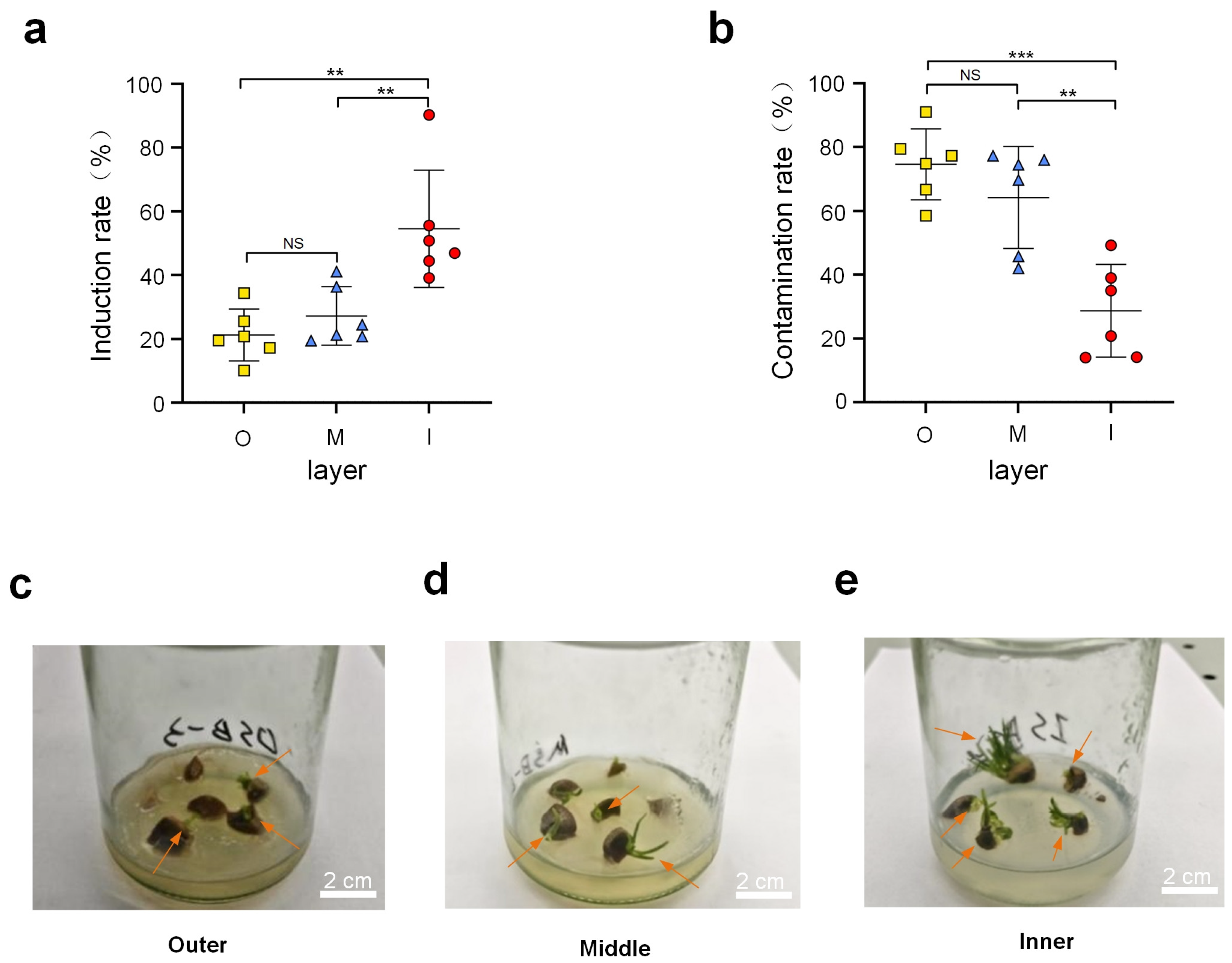
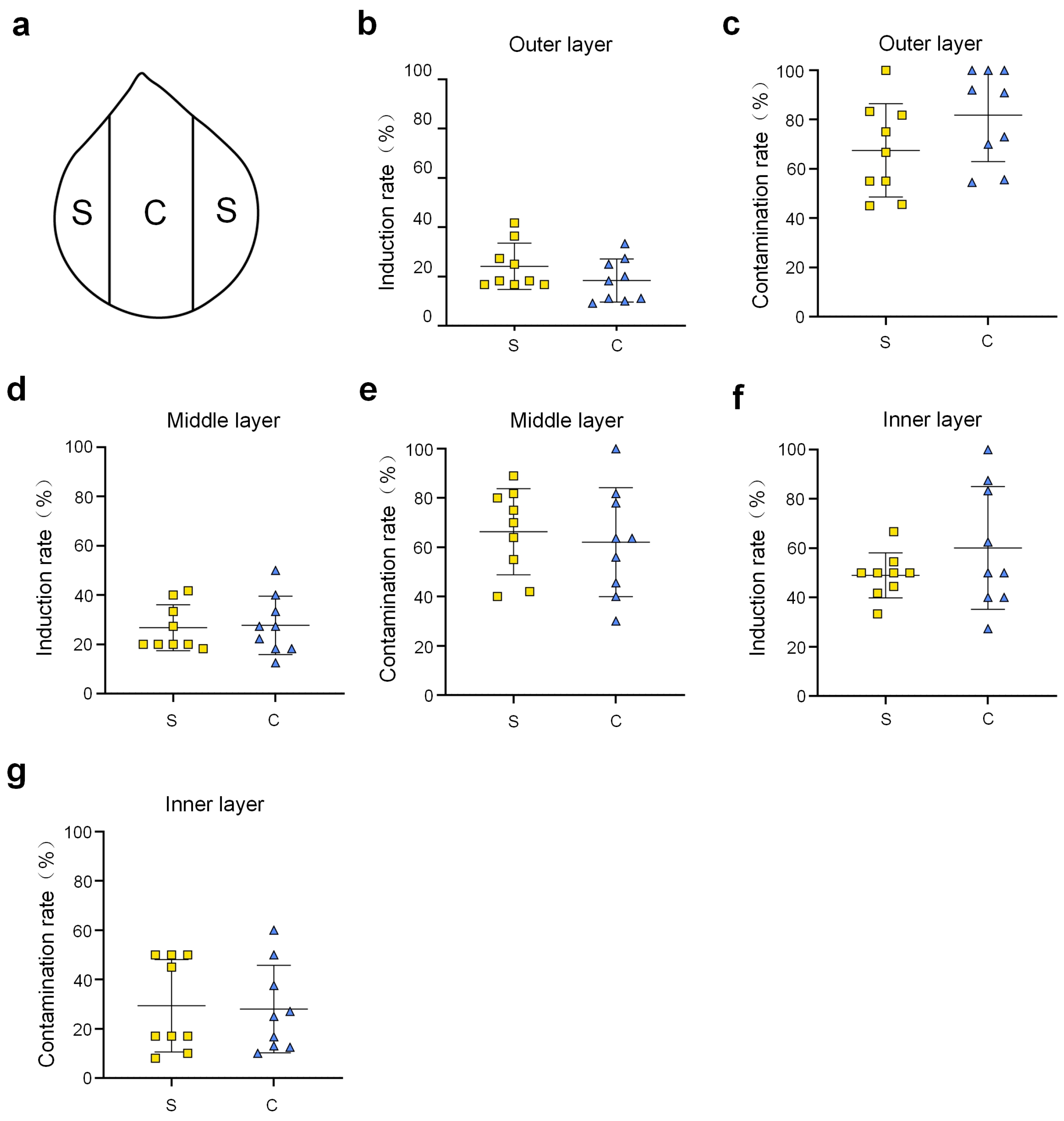
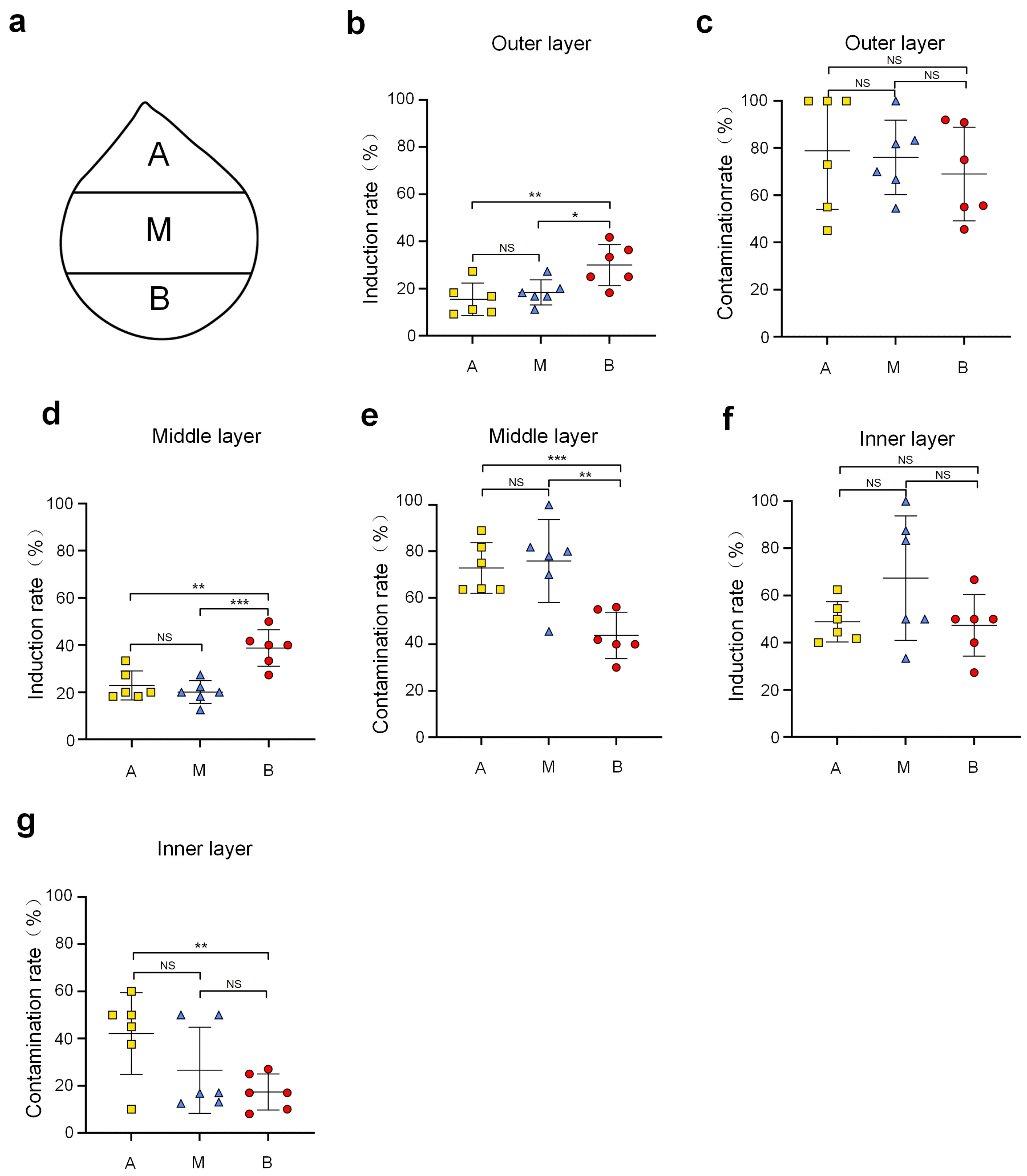
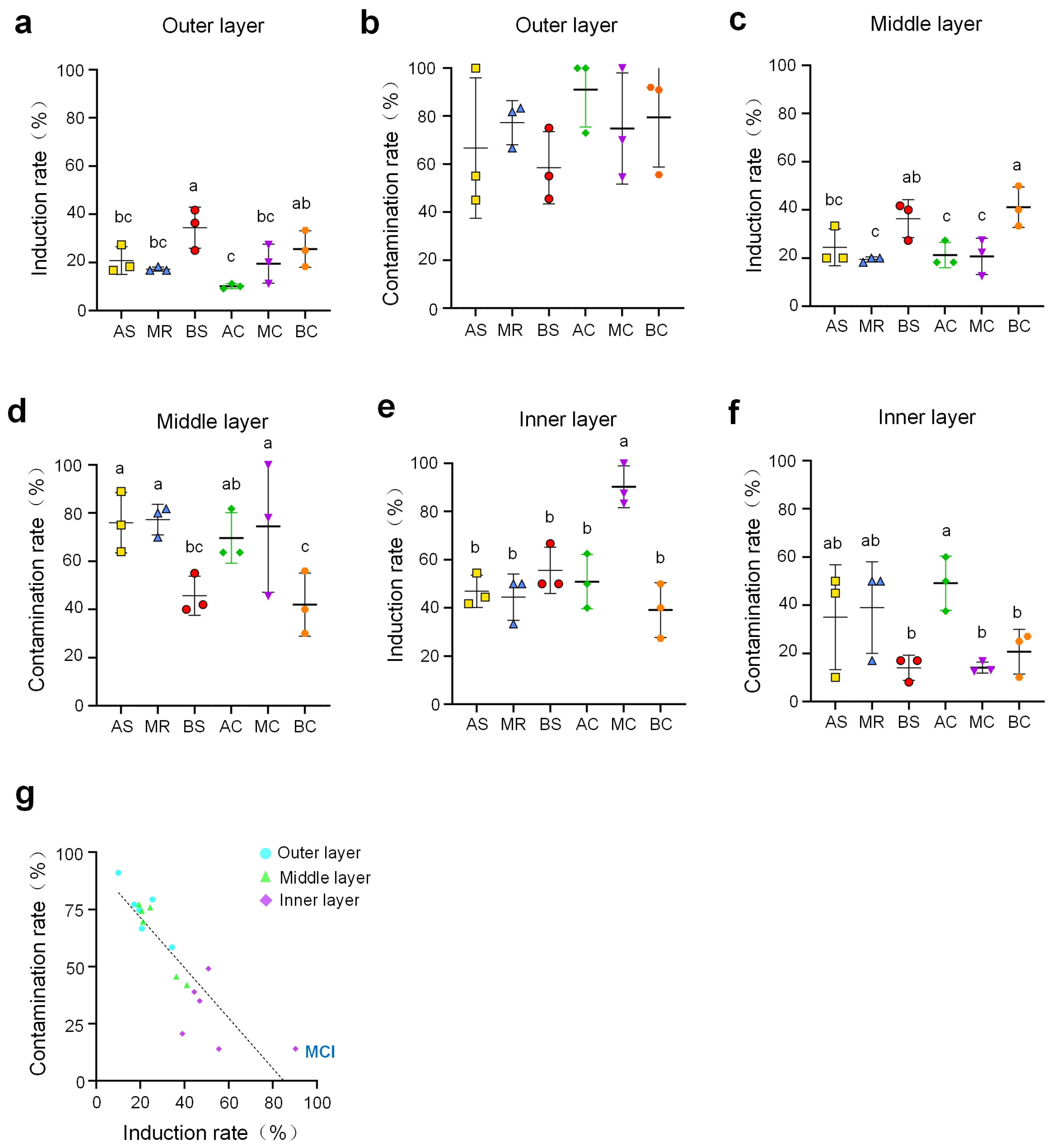
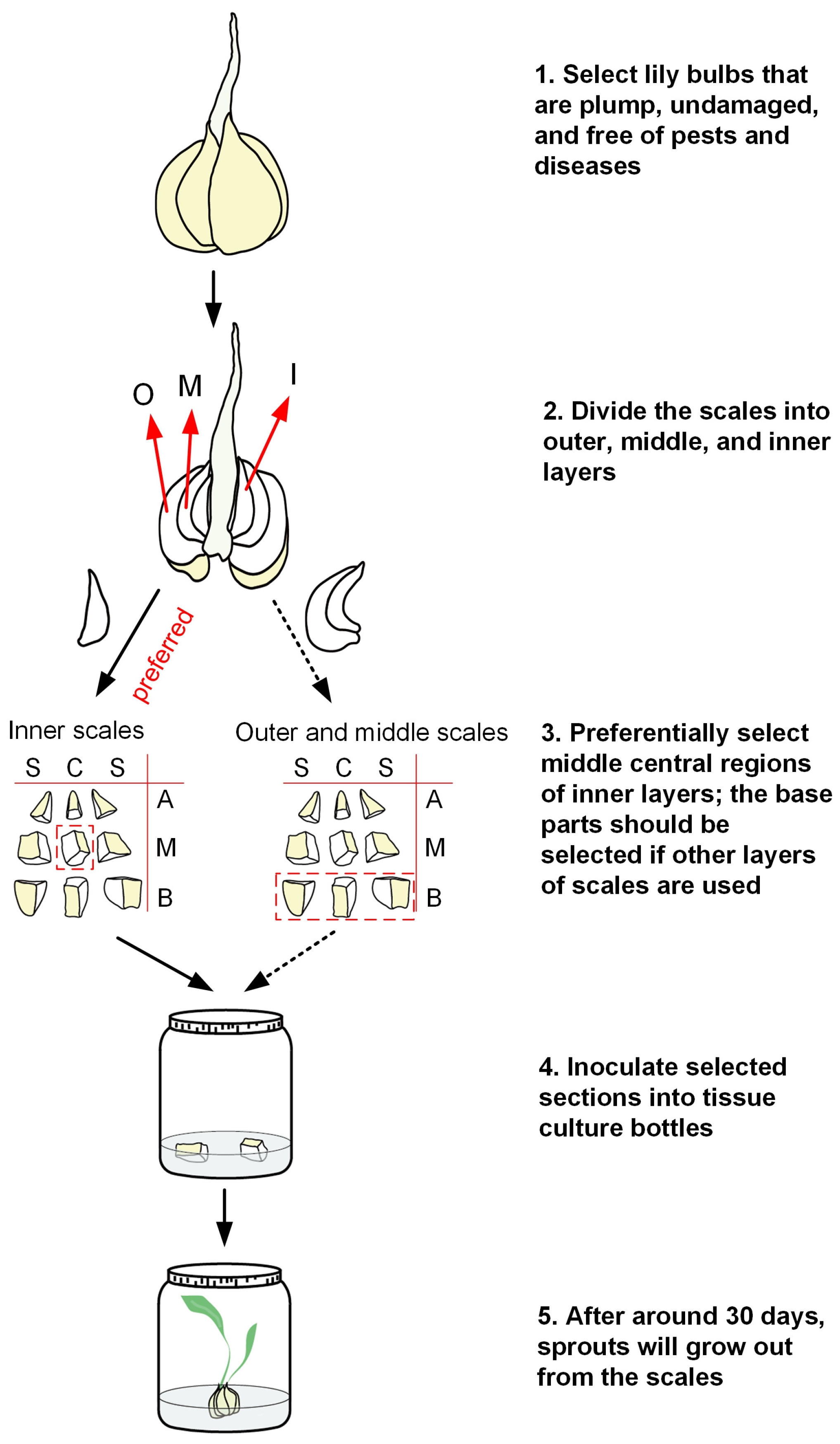
Disclaimer/Publisher’s Note: The statements, opinions and data contained in all publications are solely those of the individual author(s) and contributor(s) and not of MDPI and/or the editor(s). MDPI and/or the editor(s) disclaim responsibility for any injury to people or property resulting from any ideas, methods, instructions or products referred to in the content. |
© 2025 by the authors. Licensee MDPI, Basel, Switzerland. This article is an open access article distributed under the terms and conditions of the Creative Commons Attribution (CC BY) license (https://creativecommons.org/licenses/by/4.0/).
Share and Cite
Song, C.; Zhang, Y.; Luo, K.; Sajjad, M.; Zhang, H.; Xu, Y.; Ran, M.; Huang, H.; Wang, Y.; Zheng, Y. Identifying Optimal Parts of Oriental Lily Bulbs for Large-Scale Propagation Using Tissue Culture Bulb Induction. Horticulturae 2025, 11, 1203. https://doi.org/10.3390/horticulturae11101203
Song C, Zhang Y, Luo K, Sajjad M, Zhang H, Xu Y, Ran M, Huang H, Wang Y, Zheng Y. Identifying Optimal Parts of Oriental Lily Bulbs for Large-Scale Propagation Using Tissue Culture Bulb Induction. Horticulturae. 2025; 11(10):1203. https://doi.org/10.3390/horticulturae11101203
Chicago/Turabian StyleSong, Chao, Yufeng Zhang, Kang Luo, Muhammad Sajjad, Hongjia Zhang, Yue Xu, Mingdong Ran, Huameng Huang, Youguo Wang, and Yun Zheng. 2025. "Identifying Optimal Parts of Oriental Lily Bulbs for Large-Scale Propagation Using Tissue Culture Bulb Induction" Horticulturae 11, no. 10: 1203. https://doi.org/10.3390/horticulturae11101203
APA StyleSong, C., Zhang, Y., Luo, K., Sajjad, M., Zhang, H., Xu, Y., Ran, M., Huang, H., Wang, Y., & Zheng, Y. (2025). Identifying Optimal Parts of Oriental Lily Bulbs for Large-Scale Propagation Using Tissue Culture Bulb Induction. Horticulturae, 11(10), 1203. https://doi.org/10.3390/horticulturae11101203





